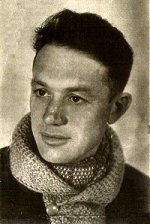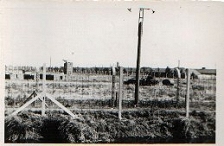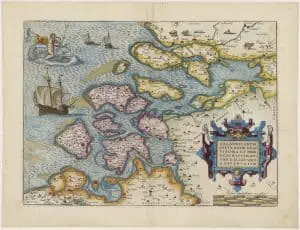Cornelis Jan Kloosterman
Neuengamme, † 1944
 In December 1938 the SS moved an external command group with one hundred inmates from the concentration camp Sachsenhausen to an empty brickwork in Hamburg-Neuengamme, which became an independent concentration camp in the early summer 1940. The site is one of the few concentration camps in Germany where most of the buildings have been conserved and serves as a memorial today. It is situated 15 km southeast of the centre of Hamburg at Jean-Dolidier-Weg in the Vierlande area. The SS also established a satellite camp of Neuengamme in Bremen in October 1942.
In December 1938 the SS moved an external command group with one hundred inmates from the concentration camp Sachsenhausen to an empty brickwork in Hamburg-Neuengamme, which became an independent concentration camp in the early summer 1940. The site is one of the few concentration camps in Germany where most of the buildings have been conserved and serves as a memorial today. It is situated 15 km southeast of the centre of Hamburg at Jean-Dolidier-Weg in the Vierlande area. The SS also established a satellite camp of Neuengamme in Bremen in October 1942.
Of the 106.000 prisoners sent to Neuengamme, about 55.0000 died, including Cornelis Jan Kloosterman in 1944, the son of my grandfathers brother Leendert.
During the war, tens of thousands of people were deported as concentration camp prisoners to Neuengamme from all over occupied Europe by the Nazis. In most cases they were incarcerated for having resisted German occupation, having refused to perform forced labor or simply as victims of racial persecution. From 80% in 1940, the proportion of Germans among the inmates decreased to approximately 10%. From the very first weeks of its existence to its liberation, Neuengamme was a deadly hell for the inmates.
Despite the nearly nonexistent food rations, the inmates had to perform hard labor in all weather and under constant beatings of the SS guards. Very soon, the mortality rate reached an incredible level. Starvation, physical abuse, and total lack of hygiene and medical care very soon killed hundreds of inmates. The Camp existed from December 13, 1938 through May 4, 1945 and had a total of 106,000 inmates during this time. These were spread over the main camp (213,000 m2) and 96 outposts across the north German area. Inmates were from 28 nationalities and also from the local Jewish community, but also included communists, homosexuals, prostitutes, gypsies, Jehovah’s Witnesses, prisoners of war and many other groups. 55,000 fell victim to the subhuman conditions in the camp consisting of hard manual work with insufficient nutrition, very unhygienic conditions and violence from the guards.



Work at the mother camp was centered on the production of bricks. This included the construction of a canal to transport the bricks to and from the site. Inmates had to excavate the heavy, peaty soil with inadequate tools and regardless of weather conditions or their health state. From 1942 on, the inmates were forced to work in the Nazi armament production. Initially the work was performed in the workshops of the camp but soon it was decided to transfer prisoners to the armaments factories located in the surroundings areas.
At the end of the war, the external kommandos of Neuengamme spread all over northern Germany. Because of the Allied advance, hundreds of inmates were also forced to dig antitank ditches. In many large north German cities, concentration camp prisoners cleared rubble and removed corpses in the wake of bombing raids.
Several original buildings of the camp continued to serve as a prison (like the one number 9). There is a good museum located at the south end of the site. In the summer of 1944, Neuengamme received many women prisoners from Auschwitz, as well as some SS matrons, or Aufseherin. Today several fomer guards are known by name, including Kaethe Becker, Erna Dickmann, Johanna Freund, Angelika Grass, Kommandofuhrerin Loni Gutzeit (who also served at Hamburg-Wandsbek and the prisoners nicknamed “The Dragon of Wandsbek”), Gertrud Heise, Frieda Ignatowitz, Gertrud Moeller, who also served at Boizenburg subcamp, Lotte Johanna Radtke, chief wardress Annemie von der Huelst, Inge Marga Marggot Weber. Many of the women were later dispersed to female subcamps throughout northern Germany.
Today we know that female guards staffed the subcamps of Neuengamme at Braunschweig SS-Reitschule, Hamburg Sasel, Hamburg Wandsbek, Helmstedt-Beendorf, Neugraben, Obernheide, Salzwedel, and Unterluss (Vuterluss). Only a few have been tried for war crimes, including Susanne Hille (who served as head woman guard at Unterluss), and Anneliese Kohlmann (who served as one of only six woman guards at Neugraben).
The estimated number of victims in Neuengamme is approximately 55,000. Thousands of inmates were hanged, shot, gassed, killed by lethal injection or transferred to the death camps Auschwitz and Majdanek. Prisoners in the Neuengamme camp were also used as subjects for medical experiments. Dr. Ludwig-Werner Haase, for example, tested a new water filter by adding 100 times the safe dose of arsenic to water. He then filtered the water using the new machine, and gave it to more than 150 prisoners over a 13-day period. The heavy doses involved in the test probably caused long-term injury to the prisoners. SS doctors also subjected some Neuengamme prisoners, including children, to medical experiments involving tuberculosis. In the last weeks of the war, the SS decided to evacuate Neuengamme.
This was the start of one of the worst death marches of the war. During these death marches, approximately 10,000 inmates perished by shootings or simply starvation. The destination of one of these death marches was Neustadt, a German haven where the inmates had to be transported on a liner transformed into a military freighter: the “Cap Arcona”. On April 27th, 1945, another freighter, the “Athen”, arrived in Neustadt with 2,500 inmates from the Dora concentration camp. They were immediately transferred to the “Cap Arcona”. Another ship, the “Thielbeck”, arrived later with 2,500 inmates from other camps. On May 3rd, 1945, 3 PM, three “Typhoon” fighters from the RAF attacked the three ships. There were 7,500 inmates on board. Only 500 of them survived.
Three of the camp’s outposts also serve as public memorials. These are located at Bullenhuser Damm, Kritenbarg 8 and Suhrenkamp 98. The first of these is a memorial to the murder of 20 children from Auschwitz concentration camp that had been taken to Hamburg and abused for medical experiments. On April 20, 1945, only weeks before the war was over, they were killed to cover up that crime. The second is an outpost of Neuengamme concentration camp where Jewish women from the Lodz Ghetto in Poland were forced to do construction work. The third one is located inside the gatehouse of the Fuhlsbüttel penitentiary.
Parts of this complex served as concentration camp for communists, opponents of the regime and many other groups. About 450 inmates were murdered here during the Nazi reign. All in all, there were 96 sub-camps, with 20 sub-camps for women. In early spring 1945, more than 45,000 inmates were working for the Nazi industry, with a third of women among them. At this time, the internal population of Neuengamme was 13,500 and the camp was completely overcrowded.
After the war, the former concentration camp buildings were initially used to intern members of the SS, NSDAP functionaries and officials of the Wehrmacht and the Nazi State. In 1948, the British occupation authorities returned the camp to the Free and Hanseatic City of Hamburg which then established a correction centre on the premises. In the late 1960s the judical authorities built a further prison within the former concentration camp, on the spot where the camp’s clay pits and stockpiles had been located.


